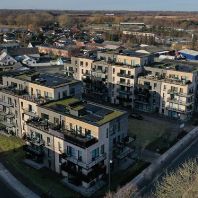A shift to Asia in the global economy meant that office markets in the world's three top financial centers London, Hong Kong and New York - recovered at varying speeds from the impact of the global financial crisis, according to a new report from leading global real estate adviser CB Richard Ellis (CBRE).
Central London recorded a relatively early rebound in leasing activity and prime rents, boosted by a number of large deals which saw gross take-up increase by 60% to 15 million ft² in 2010, although momentum slackened as the Central London market entered 2011. As in New York, the initial upturn in demand owed much to occupier requirements being reactivated after the downturn and tenants taking advantage of lower rents and generous incentives.
Prime quality office assets in Central London experienced rapid positive repricing which began in mid-2009, this reflected a sharp re-compression of prime office investment yields and capital value uplifts of more than 40% on prime Central London office space by the end of 2011. The rise in investment transaction volumes also picked up relatively quickly from the low levels of early 2009, driven strongly by the city's success in capturing a disproportionate share of global capital flows in search of prime real estate.
With a rapid rebound in office demand, Hong Kong's office market recorded a sharply falling vacancy rate through 2010. Prime office rent climbed by 40% in the year to the end of the first quarter in 2011. High investment demand, boosted by capital inflows from China, drove down office yields to produce a dramatic uplift in capital values; the CBRE Capital Value Index for prime Hong Kong offices rose by 150% in the two years to Q1 2011, surpassing its pre-crisis peak by 35%.
In New York the more severe impact of the financial crisis on the office sector made for a slower recovery. The Manhattan market witnessed a slower pace of decline in vacancy during 2010 and a significant upturn in prime rents became apparent only in Q1 2011. The New York office investment market, with its high reliance on securitized debt, remained largely frozen through 2009, but thawed during 2010 as debt markets improved and commercial mortgage-backed securities (CMBS) issuance began to resume. Capitalization rates have compressed sharply from their mid-2009 peak, reflecting low interest rates and improving economic conditions.
The report identifies an important factor supporting rental recovery in all three cities as the absence of a significant overhang of new development supply after the downturn. All three cities face a squeeze in new office supply for at least the next two years. This will lead to higher rents and pressure on occupiers to take the pre-letting route to satisfy major requirements.
Peter Damesick, Chief Economist EMEA, CB Richard Ellis, commented: "The latest cycle of recession and recovery has confirmed the characteristic trait of high volatility in the office markets of global financial centers (GFCs). However, the markets in Hong Kong, New York and London have moved at varying tempos, putting them currently at different points in the rental cycle - Hong Kong led, New York lagged.
"The contrasts in the pace of real estate recovery seen so far in the three GFCs need to be viewed in the context of the shift taking place in the global economy in favor of Asia. This is likely to be an ongoing drive of differences in office market performance in the world's leading financial centers."
Source: FD







